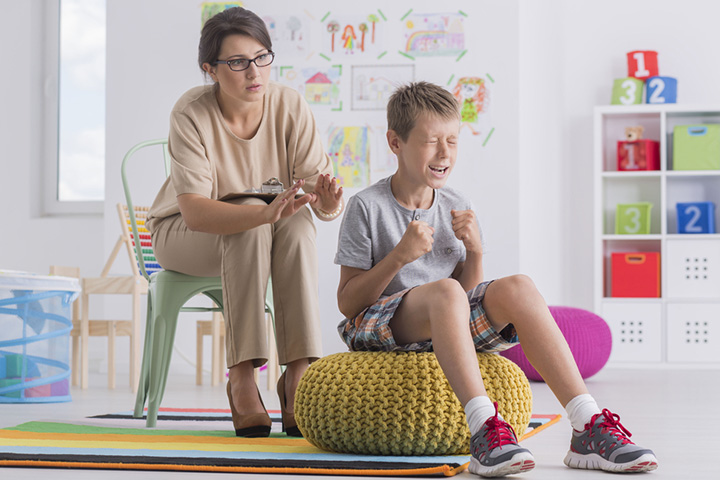Image: Shutterstock
Manipulation refers to the use of skillful tactics to gain an advantage over someone or make someone give in to one’s whims and fancies. A manipulative child often uses different tactics to get what they want, whether it is attention, favorite food, or praise, from their parents, caregivers, siblings, or friends.
Sometimes, the manipulation may be verbal, such as when they speak ill of you for not being as caring and loving as you should, and at other times, it could manifest in different forms, such as making you feel guilty or doing a favor so that you feel obliged to comply (1).
Read on as we tell you the common traits of a manipulative child and give you some valuable tips on how to deal with or manage a child’s manipulative behavior.
Signs Of A Manipulative Child
The signs of manipulation are often subtle and not straightforward, and it’s not easy to pinpoint if someone’s manipulating you. However, a few of the following common signs may indicate your child is manipulating you (1).
1. Emotional outbursts
Some children do not take “no” for an answer. When you do not grant their requests, it can make them highly exhausted. Such children can go out of control and find it challenging to handle their emotions, resulting in sudden outbursts, aggression, rudeness, or crying. Such emotionally intense behavior may confuse the parents and make them oblige to the child’s request.
2. Temper tantrums
Another common sign of a manipulative child includes throwing temper tantrums. It is characterized by intense anger outbursts for a short period or until they have succeeded in getting what they want. They may resort to yelling, “I hate you,””You are the worst parent ever,””I don’t want to live with you anymore,” etc., or lay down on the floor of the toy store and cry out loud to get an expensive toy. Temper tantrums are common in young children, but you might want to step in if the behavior becomes repetitive (2).
3. Lying
Usually, to get something more from the parents, the child might resort to lying and play the victim card to let others know that their parents are not good enough. This can force parents to provide more than necessary to the children.
Besides these, the child might also resort to the following behavior.
- Guilt-tripping someone to do something for them.
- Gaslighting someone or making them doubt their own judgments.
- Using emotional blackmail.
Ways To Deal With Or Manage A Manipulative Child
Here are some of the strategies that you could adopt to manage your child’s manipulative behavior.
1. Set some goals
Setting goals is crucial to achieving any target. At times, children are bound to use manipulation to get what they want. However, if you feel their behavior is becoming repetitive, try to set specific goals for them.
For instance, you could challenge the child to patiently wait for seven days for a specific request of theirs to be heard. This would help the child pause and control the urge to do something spontaneously. One week can do wonders for the child’s temperament, and it shuts the door for manipulation and immediate gratification.
2. Create an action plan
An action plan is something that you can let your child follow whenever they need attention or request something. This action plan should be prepared considering your family values and desirable personality traits. Here’s an example of an action plan that you could customize for your child.
Stay silent for at least 60 seconds after requesting something.
Ask again after 60 seconds if you do not receive a response.
Mention why you would want someone to accept your request.
Listen to the other person’s reasons.
An action plan can be prepared based on the goals planned in the previous strategy. Pick an action based on the written goals and ensure the targets, that is, healthy and desirable behaviors that the child must show, are doable. You may pin the goals and actions plans on a wall or refrigerator to remind the child of the appropriate and expected ways to request something and get something without showing manipulative behavior.
Use your creativity and consider the child’s interests and personal preferences to add to the list of goals and actions. Any action that is comfortable to do for you and your child will help modify the child’s behavior realistically and quickly.
3. Distract the child
Using distraction is another excellent way to manage children’s manipulative behavior. Several studies suggest that young children have the ability to adopt simple coping mechanisms, such as engaging in play or thought that distract them, when faced with delayed gratification (3).
The idea is to find a few distracters that fit the sensory modalities of the child, and you can always create your list by exploring accessible options.
Visual distracters can be anything that a child finds interesting and pays attention to for a few minutes. The visual stimulus may range from an attractive image of a favorite colorful animal or a cartoon character.
Auditory distracters include sounds and voices of something different than the regular sounds the child listens to; for example, a piece of unique and calming music or the sound of a bird.
Tactile distracters include living or non-living objects that offer stimulation. Touch is a powerful distracter that immediately gives a warm feeling, and there are many ways to use this powerful tool. Shake both hands of your child while maintaining eye contact, press the back of their hands with your thumbs, or massage them with a warm cloth or cold water bottle depending on the temperature.
You can always combine different modalities to raise the efficiency of this method. The other two sensory modality-based distracters are smell and taste. These can also be utilized based on one’s preference and availability of resources.
4. Be a role model
Shaping others by projecting oneself as a model to follow is a common and effective strategy. We, as human beings, learn to behave by observing others, a process also called social learning.
The parents can present themselves as role models and show the child how to be patient when they need something from someone. They can do a role-play in front of the children to teach them the appropriate way to wait for something upon request. This method is effective for teaching social interaction, communication, self-control, and much more.
The parents can also adopt an indirect role modeling method such as showing a video or narrating a story that includes lessons on manipulative behavior management. The video or story would contain characters that are separated from the child’s identity, thus helping you avoid blaming and shaming while teaching them.
5. Participate and instruct
Guided participation is when the children and parents learn something together. This can be made possible by reading a story together or role-playing. Role reversal is a form of psychodrama that allows children and adults to express their feelings, gain insights about each other, and encourage and practice good behavior. This is also an opportunity for the parent to view the world from the child’s perspective.
Use a variety of activities for this purpose. For instance, you could write stories, do meditation and mindfulness activities, do physical activities such as dancing, draw different characters, or recreate a situation using dialogues.
The actions of the parents in this method are crucial. Make sure children speak and act more than you, and you listen patiently rather than reacting at once. Your choice of words and how you show patience when doing these activities together can go a long way in teaching your child how to behave.
6. Set clear rules
Rules do not need to be strict enough to restrict the child’s thoughts and actions. Set flexible rules for all family members, and let them know what they should and shouldn’t do. The rules can be written in this structure:
- Everyone can ask for an extra snack only once a day.
- If someone asks for an extra snack twice a day, they can ask for it again only after two days.
- If someone asks for an extra snack more than twice, they need to wait for a week before making another request for an extra snack.
These are simple but clear instructions to set boundaries and can be placed in the dining area. Similarly, other rules can be made using a similar strategy to let children make logical decisions. This also teaches them responsibility, and the chances of throwing tantrums become much lesser.
7. Provide realistic rewards
Offer rewards, both tangible and intangible, when your child displays good behavior or is able to control their manipulative behavior. The rewards must be predictable and clearly stated to motivate your child to learn self-control and patience. An example of a reward list can be:
X will receive an extra hour to watch cartoons on Sunday if they do not behave in a certain way for four days.
You can make a reward list for every child and modify the rewards or frequencies based on each child’s interest and motivation level.
8. Provide opportunities for catharsis
Catharsis is the psychological process of releasing distressful and negative emotions to lessen the burden from our soul. Everyone needs it at some point. When people keep their feelings to themselves, they often find it hard to get away from them and end up in outbursts that can harm them and others around them.
There are several ways in which you could help your child pour out their pent-up emotions or express themselves freely. Here are a few.
- Play a verbal game with your child where each of you names something that annoys you or shares an incident that has hurt you.
- Ask open-ended questions as it allows children to share a lot more. Make a list of such questions, and feel free to ask them any of these questions daily when the child is relaxed.
- Another idea is to write a letter to someone without sending it to them. Fill the letter with all the disturbing thoughts and expressions that the child would like them to know and discard the letter, burn it, or tear it into small pieces.
9. Engage them in journaling
This approach focuses on maximizing the child’s mental health. Journaling involves writing down all your thoughts and feelings, both good and bad. This is an excellent way for your child to stay positive and purge themselves of all the thoughts and feelings that that are holding them back. A few things that they could include in the journal to start feeling positive include
Three compliments someone gave me
One person who always supports me
Two people who always help me
Ask your child to set a time to reflect on their day and maintain a colorful journal to remember and record the happiness and pain they experienced. They could also write down what they did for others during the day, such as
- Appreciated someone’s effort
- Praised a friend
- Offered a helping hand to a neighbor
10. Help them manage stress
Stress usually triggers a child or anyone to show anger and display irritable behavior. And the triggers of stress can be anything, from objects to timings, places, people, and events, which may cause the child to kick off. To avoid the activation of the child’s manipulative acts, try to create a relaxed atmosphere at home. You could also learn more about stress in children and some coping skills to help your children face any situation.
11. Engage them in healthy family activities
Involve your child in planning daily meals, weekly activities, and leisure time to strengthen your bond and build a deep and strong relationship with them. You could also do various activities together after school and during the weekends.
Sometimes, your child’s antics and manipulative behavior can get to your nerves, and managing their behavior can be overwhelming, considering that it may not always be conspicuous. Try any or a few of the tips given here, and if despite all your efforts, there seems to be no positive outcome, always feel comfortable to ask for help from a professional.

































